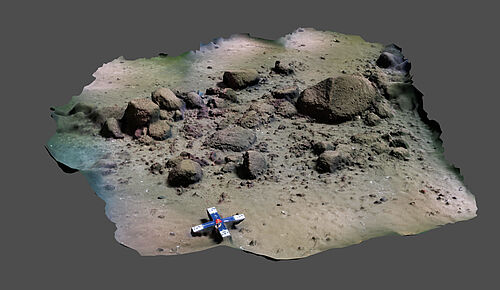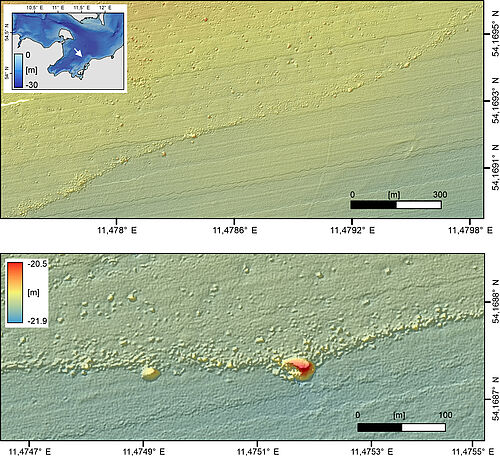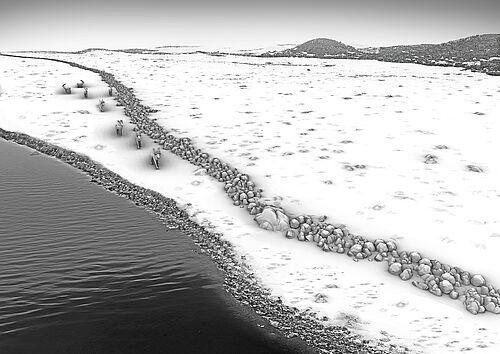The discovery of the hunting site
Originally, a team of researchers and students from Kiel University (CAU) wanted to investigate manganese crusts on a ridge of basal till that forms the seafloor about 10 kilometres off Rerik in Mecklenburg Bight. During their survey, however, they discovered a 970 metre long, regular row of stones. The structure consists of around 1,500 stones, usually some tens of centimetres in diameters, that connect several large meter-scale boulders. The researchers reported their discovery to the Mecklenburg-Vorpommern state agency for culture and monument preservation (Landesamt für Kultur und Denkmalpflege Mecklenburg-Vorpommern LAKD M-V), which then coordinated further investigations.
The stonewall is located on the south-western flank of a ridge of basal till trending roughly parallel to an adjacent basin in the South, presumably a former lake or bog. Today, the Baltic Sea is 21 metres deep at this location. Thus, the stonewall must have been built before the sea level rose significantly after the end of the last ice age, which happened for the last time around 8,500 years ago. Large parts of the previously accessible landscape ultimately flooded at that time.
Scientists from the Leibniz Institute for Baltic Sea Research Warnemünde (IOW), the research priority area at Kiel Marine Science at Kiel University, the University of Rostock, the Centre for Baltic and Scandinavian Archaeology (ZBSA, since 2024 part of the Leibniz Centre for Archaeology LEIZA), the German Aerospace Center (DLR), the Alfred Wegener Institute, Helmholtz Centre for Polar and Marine Research (AWI) as well as the LAKD M-V used modern geophysical methods to create a detailed 3D model of the wall and to reconstruct the structure of the ancient landscape. Using sediment samples from the adjacent basin to the south, it was possible to narrow down the possible period when the wall could have been built. Furthermore, research divers from the universities of Rostock and Kiel explored the stonewall.
The results to date
“Our investigations indicate that a natural origin of the underwater stonewall as well as a construction in modern times, for instance in connection with submarine cable laying or stone harvesting are not very likely. The methodical arrangement of the many small stones that connect the large, non-moveable boulders, speaks against this,” explains Jacob Geersen, lead author of the study now published in the renowned journal Proceedings of the National Academy of Sciences (PNAS). As part of the new IOW research focus “Shallow Water Processes and Transitions to the Baltic Scale” Geersen is investigating geological and anthropogenic processes in the Baltic Sea region.
Excluding natural processes and a modern origin, the stonewall could only have been formed after the end of the last ice age, when the landscape was not yet flooded by the Baltic Sea. “At this time, the entire population across northern Europe was likely below 5,000 people. One of their main food sources were herds of reindeer, which migrated seasonally through the sparsely vegetated post-glacial landscape. The wall was probably used to guide the reindeer into a bottleneck between the adjacent lakeshore and the wall, or even into the lake, where the Stone Age hunters could kill them more easily with their weapons,” explains Marcel Bradtmöller from the University of Rostock.
Comparable prehistoric hunting structures have already been found in other parts of the world, for example at the bottom of Lake Huron (Michigan) at a depth of 30 metres. Here, US archaeologists documented stonewalls as well as hunting blinds constructed for hunting caribou, the North American equivalent to reindeer. The stonewalls in Lake Huron and in Mecklenburg Bight share many characteristics such as a location on the flank of a topographic ridge, as well as a subparallel trending lakeshore on one side.
As the last reindeer herds disappeared from our latitudes around 11,000 years ago, when the climate became warmer and forests were spreading, the stonewall was most likely not built after this time. This would make it the oldest human structure ever discovered in the Baltic Sea. “Although numerous well-preserved archaeological sites from the Stone Age are known from the Bay of Wismar and along the coast of Mecklenburg-Vorpommern, these are located in much shallower water depths and mostly date to the Mesolithic and Neolithic periods (approx. 7,000 - 2,500 BC),” explains Jens Auer from the Mecklenburg-Vorpommern State Office for Culture and Monument Preservation (LAKD M-V), who was involved in the exploration and sampling of many of these sites.
What’s next?
The stonewall and the surrounding seabed will be investigated in more detail using side-scan sonar, sediment echo sounder and multibeam echo sounder devices. Additionally, research divers from the University of Rostock and archaeologists from the LAKD M-V are planning further diving campaigns to search the stonewall and its surroundings for archaeological finds that could help with the interpretation of the structure. Luminescence dating, which can be used to determine when the surface of a stone was last exposed to sunlight, may help to get a more precise date, when the stonewall was constructed. Furthermore, the researchers intend to reconstruct the ancient surrounding landscape in more detail.
“We have evidence for the existence of comparable stonewalls at other locations in the Mecklenburg Bight. These will be systematically investigated as well,” explains Jens Schneider von Deimling from Kiel University. Overall, the investigations can make a significant contribution to understanding the life, organisation and hunting methods of early Stone Age hunter-gatherers.
Find the press release in pdf format here.
Original publication:
J. Geersen, M. Bradtmöller, J. Schneider von Deimling, P. Feldens, J. Auer, P. Held, A. Lohrberg,R. Supka, J. J. L. Hoffmann, B. V. Eriksen , W. Rabbel , H.-J. Karlsen, S. Krastel, D. Brandt, D. Heuskin, H. Lübke (2024): A submerged Stone Age hunting architecture from the Western Baltic Sea https://doi.org/10.1073/pnas.2312008121
Scientific Contact:
Dr. Jacob Geersen | Leibniz Institute for Baltic Sea Research Warnemünde | jacob.geersenio-warnemuendede
Dr. Marcel Bradtmöller | University of Rostock | marcel.bradtmoelleruni-rostockde
Dr. Jens Schneider von Deimling| Kiel University | jens.schneiderifg.uni-kielde
Press contacts:
IOW: Dr. Kristin Beck | phone: +49 (0)381 5197 135 | presseio-warnemuendede
University of Rostock: Dr. Kirstin Werner | phone: +49 (0)381 498-1013 | kirstin.werneruni-rostockde
CAU: Friederike Balzereit | phone: +49 (0)431 880-3032 | fbalzereituv.uni-kielde



